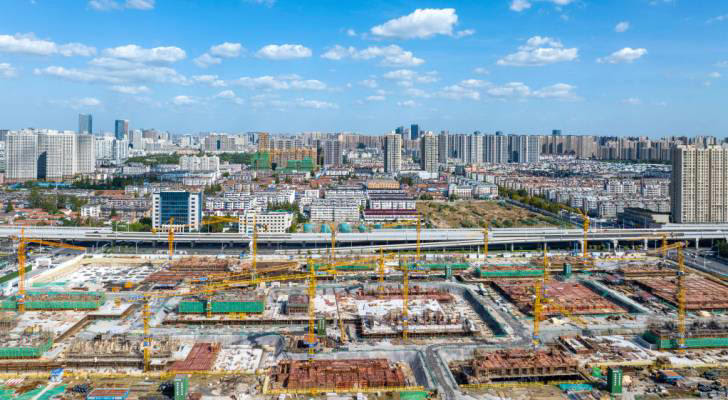
Inside the Diverse and Growing Asian Population in the U.S. – Bing video
For decades, China has seen relentless growth in power and economic prosperity.
But there are growing signs that the economic miracle has ended and that the path to further Asian socioeconomic status – Search (bing.com) growth in the years ahead will
be more difficult. But does that mean China has lost its chance to overtake the U.S.?
Here’s a closer look ~ Don’t miss.
Commercial real estate has outperformed the S&P 500 over 25 years.
Here’s how to diversify your portfolio without the headache of being a landlord
Rich young Americans have lost confidence in the stock market — and are also
betting on these 3 assets instead. Get in now for strong long-term tailwinds
‘A natural way to diversify’: Janet Yellen now says Americans should expect
a decline in the USD as the world’s reserve currency — 3 ways you can prepare
China’s growth model
China’s gross domestic product (GDP) per capita, adjusted for inflation, surged from
$293 in 1985 to more than $12,000 in 2021. Demographics, exports & capital investments made this economic miracle possible. Asia Aging: Demographic, Economic, and Health Transitions.
China’s enormous population — which was the largest in the world until India’s recently surpassed it — served as cheap labor for assembling goods that were exported aggressively. Meanwhile, the government invested heavily in infrastructure to support this export-led growth model and boost standards of living.
INTRODUCTION
Asia Aging: Demographic, Economic, and Health Transitions (census.gov)
Written by: Wan He, Daniel Goodkind, and Paul Kowal,
With Issa Saleem Almasarweh, Thanh Long Giang, Mohammad Mainul Islam,
Samsik Lee, Bussarawan Teerawichitchainan, and Nai Peng Tey
This report addresses the demographic, economic, and health transitions that have taken place in Asian countries, while considering the wide diversity of economic development throughout Asia. Asia’s aging population is a reflection of the unusually rapid declines in fertility and mortality rates. Just as significant are the sheer numbers involved.
As of 2020, the population of Asia exceeded 4.5 billion (including China and India,
the two countries with over one billion each), more than one-half the world’s total.
There were an estimated 414 million Asians aged 65 and older in 2020, projected
to grow to more than 1.2 billion in 2060, which implies that one out of every
10 people in the world will be an older Asian.
Asian socio-economic collapse – Bing video
However, China’s economy has shifted from export-centric to a consumer-led,
debt-fueled model in recent years. This model is now at risk. As of July, China’s
imports and exports had fallen quicker than expected as demand softened.
Uphill battle ahead
China’s recent trade tensions with the U.S., which kicked off under the previous administration and have continued under President Joe Biden’s, have disrupted a trading relationship that was integral to the economic “miracle” of the past four decades or so.
Meanwhile, wages have been rising rapidly, according to the country’s own National Bureau of Statistics, thus narrowing the gap between Chinese workers and rivals in other markets. Consequently, China reported that its exports were down 14.5% year-over-year, as of July. Earlier in the year, Beijing said its economy had grown by only 3% in 2022, the slowest pace since the mid-1970s, not counting 2020, the first COVID year.
That’s not the only change the country is currently experiencing.
Not only is China no longer the world’s most populous country; its actually seeing population decline that could, according to UN estimates, see the country’s population
fall to less than a billion by 2080 and then less than 800 million by 2100.
Perhaps the biggest threat to China’s economic prospects is its addiction to real estate. Property has traditionally been considered the safest way to save and safeguard capital
in China. Now, residential and commercial real estate accounts for 25% of the country’s economy. Plunging home prices and failing high-profile developers like Evergrande could create a debt crisis.
In light of all this, geopolitical analyst Peter Zeihanhas told Joe Rogan he believes China probably has another 10 years before it faces significant civil unrest and economic decline.
Global implications
China’s economic growth has given it immense influence over geopolitics in recent decades, the end of which will have major implications on the rest of the world. It could mean that trade, finance and geopolitics could be U.S.-centric for longer than expected.
U.S. per capita GDP is $75,269, about six times higher than China’s.
The economy expanded 2.1% in the most recent quarter, and growth is expected to remain steady until 2033. The U.S. dollar still dominates trade and international commerce, while the country accounts for 12.4% of global economic activity.
It’s difficult to predict the future of either the U.S. or Chinese economy.
Sudden shifts in geopolitics or breakthroughs in technology would shift the picture.
China could still have a chance to overtake its biggest rival. But based on current projections, this seems unlikely.
Policymakers and investors around the world might want to prepare for a world where China’s continuing growth is no longer taken for granted.
What to read next: All Wars Caused By Economic Strife and Turmoil.
Worried about the economy? Here are the best shock-proof assets for your portfolio. (They’re all outside of the stock market.) Rising prices are throwing off Americans’ retirement plans — here’s how to get your savings back on track
Jeff Bezos and Oprah Winfrey invest in this asset to keep their wealth safe —
you may want to do the same in 2023.
This article provides information only and should not be construed as advice.
It is provided without warranty of any kind.
Has China wasted its golden opportunity to overtake the US? Here’s why one analyst is predicting it’s the country’s ‘last decade’ of power and prosperity (msn.com)
Asia Cities by Population 2023 (worldpopulationreview.com)
Asia’s developing economies outpaced the rest of the world in both population expansion and growth rate between 1970 and 20171. The urban population in Asia increased 3.4% per annum, compared to 2.6% in the rest of the developing world, and 1% in developed economies 1. According to the UN, the Asia-Pacific region became majority urban in 2019 for the first time in human history, with more than 2.3 billion people now living in cities 2. The fastest urban population growth is set to occur in secondary cities of Indonesia, the Philippines, Thailand, and Vietnam2. Another 1.1 billion people will live in the region’s cities in the next 20 years3.
Asia is urbanizing at a breath-taking speed. Of the 47 cities in the world that are defined as ‘megacities’, two-thirds are in Asia. According to the UN, the Asia-Pacific region became majority urban in 2019 for the first time in human history, with more than 2.3 billion people now living in cities. Fastest urban population growth is set to occur in secondary cities of Indonesia, the Philippines, Thailand, and Vietnam.
As these cities are growing, they face multiple slow-moving stresses at once. The governments need to manage housing and infrastructure for the millions of new city dwellers, but also expand the preparedness of their cities for slow but certain threats as climate change, gridlock, food insecurity and public health crises.
There is a critical need to strengthen resilience in cities in the Asia-Pacific by implementing strategic and long-term planning. However, many of these cities lack the capabilities to prepare funding proposals to potential financiers or investors to accelerate the development of resilience projects.
In this Asia Society Switzerland and Swiss Re event, the first in a series of two on Urban Resilience in Asia, we will explore what the different approaches are that make cities resilient against slow-moving threats, share best practices we can learn from, and explore the relation between political systems and the level of resilience of cities.
The event will take place in the beautiful auditorium at Swiss Re Next in Zurich. It can also be followed online via Microsoft Teams.
Inside the diverse and growing Asian population in the US The number of counties where people of Asian descent represent more than 5 percent of the population has risen to 176 in 2020 from 39 in 1990
The number of people who identify as Asian in the United States nearly tripled in the past three decades, and Asians are now the fastest-growing of the nation’s four largest racial and ethnic groups, according to recently released census numbers.
But in addition to the uptick, the Asian population has become geographically diverse
with wide variations in income, citizenship status and political preference, according to
a New York Times analysis of census data.
Black Americans, Asian Americans, Mexican Americans, and White Americans: Donald Trump – The Political Dynamics of ‘The Pot Calling the Kettle Black’. (msn.com)
Where are Asian American communities growing the fastest? Not California – Los Angeles Times (latimes.com)
Understanding economic disparities within the AAPI community | Economic Policy Institute (epi.org)
“Dying Cities” – 10 Major U.S. Cities That Are Shrinking at an Alarming Rate (msn.com)
Worst Fast-Food Restaurants Where We Should All Avoid Eating (standardnews.com)
The states with the highest cancer rates in the US, according to data (msn.com)
12 Easy ‘Blue Zone’ Recipes That Can Help You Live a Better Life (msn.com)
“Going Broke!” – 18 States Nearing the Abyss of Bankruptcy (msn.com)
Ranking the next five-year windows for each NFL team (msn.com)
Asian financial crisis | Causes, Effects, & Facts | Britannica Money
The Asian population is forever complex…
With a Brown Cloud Over Asia – Search (bing.com)


